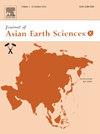Formation mechanism of the deep double-layer thermal structure in Bohai Bay Basin, eastern China, and its impact on hydrocarbon production
IF 2.3
Q3 GEOSCIENCES, MULTIDISCIPLINARY
引用次数: 0
Abstract
Bozhong Depression is the marine part of Bohai Bay Basin and is also the area with the most abundant offshore oil and gas resources in China. According to recent seismic data, kinematic evolution has resulted in a double-layer velocity structure as well as a corresponding double-layer thermal structure in the crust and mantle in Bozhong Depression. Under the influence of the India–Eurasia collision and Pacific plate subduction, Bohai Bay Basin has been subjected to active rifting and associated heat transfers since the late Cenozoic, resulting in two sets of deep and shallow oil and gas reservoir systems, which are related to the double-layer thermal structure. However, the evolution mechanism of this structure remains unclear because of lack of research on the vertical structure of the lithosphere in the area. We conducted finite-element simulations using seismic, geomagnetic, and geothermal heat flow data; results indicate synchronous uplift of deep mantle material and high-temperature crustal material in Bozhong Depression around 23 Ma. Around 5.3 Ma, retreat of the Pacific plate subduction accelerated and the deep mantle was uplifted by a small amount, creating a double-layer structure with differential uplift between the mantle and the crust. Successive synchronous and differential uplift in a double-layer thermal structure explains the anomalously high temperatures found during exploratory drilling in Bozhong Depression. Furthermore, the temperature of the sedimentary stratum in Bozhong Depression currently lies within the best window for oil and gas generation; it is the Golden Age for numerous oil and gas reservoirs.

渤海湾盆地深层双层热构造形成机制及其对油气生产的影响
渤中坳陷是渤海湾盆地的海相部分,也是中国海上油气资源最丰富的地区。根据近年来的地震资料,运动演化导致渤中坳陷地壳和地幔形成了双层速度结构和相应的双层热结构。渤海湾盆地晚新生代以来,受印度-欧亚板块碰撞和太平洋板块俯冲作用的影响,裂谷活动频繁,热传递频繁,形成了两套深层和浅层油气成藏体系,并与双层热构造有关。然而,由于缺乏对该地区岩石圈垂直构造的研究,该构造的演化机制尚不清楚。我们利用地震、地磁和地热热流数据进行了有限元模拟;结果表明,渤中坳陷23ma前后深部地幔物质与高温地壳物质同步抬升。5.3 Ma前后,太平洋板块俯冲加速后退,深部地幔少量隆升,形成地幔与地壳差异隆升的双层构造。渤中坳陷双层热构造的连续同步和差异隆升解释了渤中坳陷勘探钻探中发现的异常高温。目前渤中坳陷沉积层温度处于最佳生油窗内;这是众多油气储层的黄金时代。
本文章由计算机程序翻译,如有差异,请以英文原文为准。
求助全文
约1分钟内获得全文
求助全文
来源期刊

Journal of Asian Earth Sciences: X
Earth and Planetary Sciences-Earth-Surface Processes
CiteScore
3.40
自引率
0.00%
发文量
53
审稿时长
28 weeks
 求助内容:
求助内容: 应助结果提醒方式:
应助结果提醒方式:


